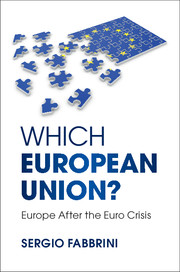Book contents
- Frontmatter
- Dedication
- Contents
- List of boxes
- List of figures
- List of tables
- List of abbreviations
- Preface – How many unions?
- Acknowledgments
- Part I Institutionalization of multiple unions
- Part II Main perspectives on the European Union
- Part III Towards the compound union perspective
- Appendix
- Glossary
- References
- Index
Preface – How many unions?
Published online by Cambridge University Press: 05 March 2015
- Frontmatter
- Dedication
- Contents
- List of boxes
- List of figures
- List of tables
- List of abbreviations
- Preface – How many unions?
- Acknowledgments
- Part I Institutionalization of multiple unions
- Part II Main perspectives on the European Union
- Part III Towards the compound union perspective
- Appendix
- Glossary
- References
- Index
Summary
The book
Which European Union (EU) is emerging from the euro crisis? The euro crisis has been a litmus test in terms of bringing the institutional properties of the EU to the surface. Those properties are the outcome of several compromises upon which the EU has been built. Those compromises reflected the different perspectives on the Union that have accompanied the latter's institutionalization as a political system. The EU has harbored more than one union within its legal and institutional order. The euro crisis has made the coexistence of those perspectives highly problematic, raising the necessity of thinking of a new political order in Europe.
The book is organized as follows. Part I identifies the institutional structure of the EU that has emerged from its multilinear institutionalization, showing how that structure reflects the interstate and political cleavages that have accompanied the formation of the EU as a political system. Part II discusses the different perspectives on the EU that have led to the numerous compromises upon which the EU has been built. I have defined them as the perspectives of economic community, intergovernmental union and parliamentary union. The euro crisis has shown their inadequacy both as descriptive and prescriptive interpretations of what the EU is and should become. Part III elaborates an alternative view on the EU's future through a comparative analysis of the models of democracy of nation states (both unitary and federal) and unions of states (such as the United States of America [USA] and Switzerland). I define as compound democracy (S. Fabbrini 2010) the democratic model of unions of states, in order to distinguish it from the models of competitive democracy and consensus democracy that characterize the democratic functioning of nation states (both unitary and federal). I argue (through the comparison of the USA and Switzerland) that the model of compound democracy, organized in a system of separate institutions sharing decision-making power, is the only suitable model for those federations constituted through the aggregation of previously independent states and politically characterized by inter-state cleavages.
- Type
- Chapter
- Information
- Which European Union?Europe After the Euro Crisis, pp. xvii - xxxiiiPublisher: Cambridge University PressPrint publication year: 2015



